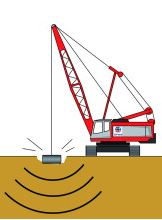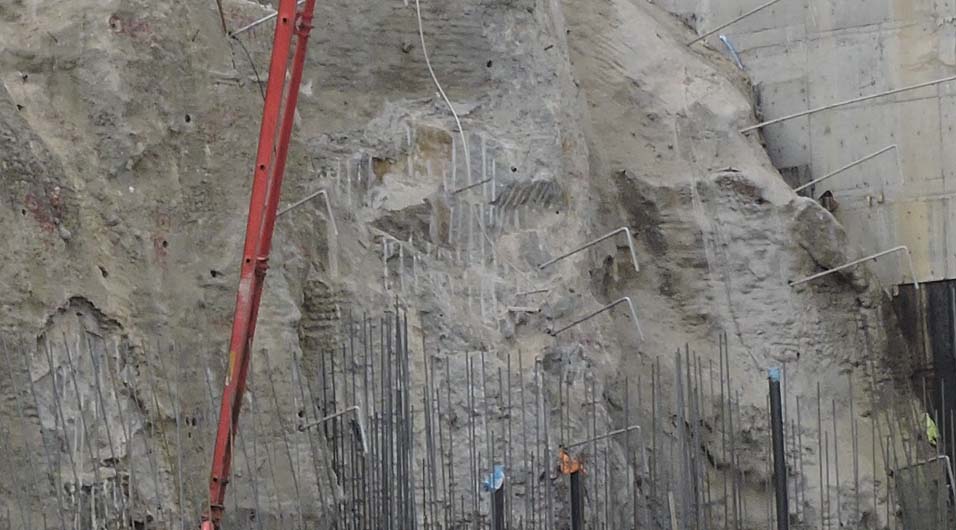Ground improvements are done specially for shallow foundations when they are constructed in weak soils. Based on the classification of soil under the foundation, the type of improvement is selected. The type of loadings will also be taken into account when the improvement technique is finalized.
There are many methods for ground improvements. However, the best suitable method shall be selected based on available resources and applicability. In addition, more importantly, affordability shall also be checked. The following methods are more commonly used for this purpose.
- Vibro Compaction
- Vacuum Consolidation
- Preloading of Soil
- Vibro-replacement stone columns
- Grouting
- Improvement by Admixtures
- Dynamic Compaction of Soil
Vibro Compaction
Compaction of the ground by vibration is the Vibro compaction. In this method, the loose ground is vibrated to change the configuration of the soil to dense form. Due to the high vibration, soil particles are rearranged to the configuration that reduces the void ratio and increases the density. This method is more suitable for sandy soils.
Ground Improvements by Vacuum Consolidation
Vacuum consolidation is a ground improvement technique used for soft soils. It is a process of applying vacuum pressure on the soil which is protected from the surface from losing the pressure by a sealing membrane.
perforated vertical drains inserted into the soil generate the vacuum pressure on the soil and it allows to drain out of the pour water. As a measure to speed up or when required higher consolidation, surcharge pressure could also be applied on the soil in addition to the surcharge applied in the form of a vacuum.

Figure 01 indicates the basic arrangement of vacuum consolidation. This method is mainly used in infrastructure development projects dredging and land reclamation, etc.
Preloading of Soil
Preloading or pre-compression is a process of applying a load on the soil to remove the pour water over time. The reduction of the pour water causes the settlement of the soil and it is an economical method when it is easy to find the soil for this purpose.

This is done prior to the construction as it is required to keep for a reasonable time depending on the design requirement to have the required settlement. This process can be implemented for compressible soft soils (soft to medium soft) such as saturated clay and silt, organic clay, peat, etc.

As a result of the preloading, primary settlement, secondary settlement and improvement of the undrained shear strength can be expected. Thus, the effect on the structure by the settlement is minimized as shown in Figure 02.
Vibro-Replacement of Stone Columns
Vibro-replacement is the construction of densely compacted stone columns in the soil. This method is suitable for improving soft soils such as clays, slits, etc. With the introduction of stone columns, the bearing capacity of the soil will improve considerably.

It is an economical and environmentally friendly method. However, the economy may vary with the availability of the machinery used for this purpose.
Ground Improvements by Grouting
Grouting is more commonly used as a ground improvement method for foundation work especially infrastructure projects such as the construction of dams. Even for building construction, this method can be applied when there is a grout taking soil.
In large infrastructure projects like dams, grout is used to fill the cavities in the rock and to decrease the permeability. As a result of grout filling, cohesion and shear strength will increase.
Cement-based grout mixtures are used commonly and admixtures that harden the grout quickly could be added depending on the requirement of the project.
When there is weak ground with sufficient permeability for flowing the grout, grout can be injected into the oil for improving its bearing capacity. This could be done as recommended by the geotechnical engineer. There are different grouting methods used in the industry especially in shallow depths.
- Compaction grouting
- Permeation grouting
- Jet grouting
Figure 04 indicates the different method of grouting used in the construction industry.

Ground Improvements by Admixtures
When it says the admixtures, it is alway not the chemical admixtures most people think. Mainly there are two types of admixtures namely inert admixtures and chemical admixtures.
Inert admixtures consist of inert materials that do not react with soil but improve the density, grain size distribution, shear strength and bearing capacity and reduce the porosity and permeability.

Chemical admixtures are usually lime, cement, industrial wastes and combination of industrial wastes and other chemicals available in the market.
Industrial wastes consist of different materials
- Coal combustion products such as fly ash and bottom ash
- Ground granulated blast furnace slag (GGBS)
- Cement kiln dust
- Lime kiln dust
Ground Improvements by Dynamic Compaction of Soil
Dynamic compaction involves dropping heavyweight on the soil in a regular sequence to increase the density of the soil. This method is used in infrastructure projects especially when there is a large area to be improved.

Weight to be dropped is selected based on the degree of compassion required. Selection shall be done on the direction of the geotechnical engineer. This method is suitable for all granular soils to mention in the following list.
- Non-organic
- Non-homogeneous fill
- Made grounds (areas of land that is man-made by reclamation)
- Reclamation areas with different characteristics
- When underground obstructions are presents
- Soils with large air voids (refused dumps, poorly filled ground, etc.)
The use of this method provides more advantages such as the compact large area of loose granular fill, reduce the volume of landfill waste, increase the density and bearing capacity of the soil and reduces the post-construction settlements.


![Tunnel Design [a guide to designers]](https://www.structuralguide.com/wp-content/uploads/2019/11/Tunnel-1-1024x599.jpg)